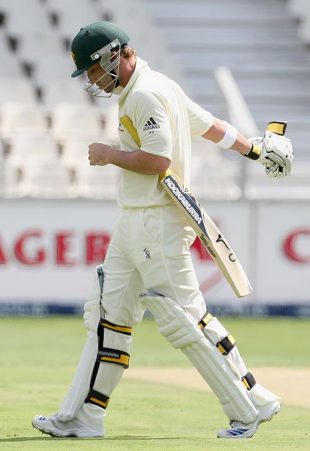All stats exclude Tests involving Bangladesh and Zimbabwe.
Two matches this week - in Karachi and Johannesburg - offered good examples of the worst and the best of Test cricket. The Karachi game yielded 1553 runs and 18 wickets, and till the last session on the last day was a wretchedly unequal contest between bat and ball; the Johannesburg game, after only one day, was building up into another superb battle between the two best teams in the world.
Much of it had to do with the conditions at the two venues, and as the stats below indicate, these weren't one-off instances either - over the last four years, the conditions in Pakistan and South Africa are at the two ends of the spectrum, in terms of their degrees of difficulty for batsmen. Pakistan has the highest runs-per-wicket figure, of 43.96, with 40 centuries in 12 Tests (all stats exclude matches involving Bangladesh and Zimbabwe), an average of more than three per game. India and Australia are next in the list, and then it gets progressively tougher for batting, with South Africa being the ultimate test for batsmen - the average here over the last four years (excluding Tests involving Bangladesh and Zimbabwe) is 29.94, and 20 Tests have only produced 28 centuries, an average of 1.4 per match. In
78 innings, only three times have teams topped 500; in
43 innings in Pakistan, that landmark has been exceeded eight times, with five being 600-plus scores.
Not surprisingly, Pakistan has also produced the highest percentage of drawn games during this period: half the Tests here - six out of 12 - have ended in a stalemate. In South Africa, on the other hand, there have only been two draws out of 20, and even then, one of those - the game against England
in Centurion - was clearly affected by the weather, with the entire first day being lost. The only country with a lower draw percentage is Australia - two in 23. They've managed more results despite a relatively high batting average, primarily because the Australian batsmen have scored prolifically but have managed to get opposition players out pretty cheaply.
Batting has been particularly difficult for openers in South Africa, which made Phillip Hughes' job the most unenviable - making his debut, and opening the batting against arguably the best new-ball pair, in conditions that are toughest for batsmen at the top of the order. Hughes' first-over duck made him the
70th opener to fall without scoring on debut, and the third in the last 10 months. If it's any consolation, Tharanga Paranavitana did the same in much easier batting conditions just five days earlier.
In general, though, Pakistan has been much kinder to openers, producing an average stand of almost 47, with four century partnerships in 12 Tests. The slow pitches of West Indies have been favourable for opening stands too, as have conditions in India and England. As the next table shows, though, opening in South Africa is an entirely different proposition: the average stand here is a measly 24.54, almost half the average in Pakistan. In 78 opening partnerships in the last four years, only once have two openers gone on to a century partnership, and the pair was a rather unlikely one: Wasim Jaffer and Dinesh Karthik added 153
in Cape Town, in a game India eventually lost.
Looking at all opening pairs who've batted together at least five times in South Africa during this period, only one - Matthew Hayden and Justin Langer - touches the 35-mark in terms of average partnership. Even that is well below their career average opening stand of 51.88. What also stands out is the struggle for the home team openers: Graeme Smith and Herschelle Gibbs average 13.30 in 13 innings, while Gibbs and AB de Villiers average 17.80. Smith and Neil McKenzie added 102 against Bangladesh last year, but the last time one of the South African opening pairs put together a century stand against the top eight teams was more than five years ago, when Smith and Gibbs added a monumental 301
in Centurion in January 2004.
And as those numbers suggest, South Africa is the favourite venue for fast bowlers during this period: the rate at which 10-wicket hauls have been taken by fast bowlers here is five times the rate at which century partnerships have been scored for the opening wicket. The 23 five-fors in 20 Tests means an average of 1.15 per game.
Pace bowlers have been effective in New Zealand as well - good news for Zaheer Khan, Ishant Sharma and Co - but it's been much more of a struggle in Australia. AB de Villiers said that conditions would favour the fast men more in South Africa than in Australia: "There'll be a bit more swing over here in South Africa. It will definitely favour the bowlers a bit more than what we saw in Australia. There wasn't a lot of swing there." On the evidence of the action on the first day of the Test in Johannesburg, his analysis was spot on.
Australia are without Stuart Clark and Brett Lee on their current tour, which is a huge loss for both have done exceptionally well in their only sojourn to South Africa - Clark's 20 wickets came at 15.85 apiece, while Lee averaged 19.52. Unlike the South African opening batsmen, their new-ball bowlers have enjoyed the seamer-friendly conditions and have utilised them well - Dale Steyn averages 19.19 and Makhaya Ntini 23.72.
